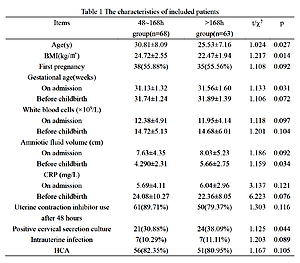Current issue
Archive
Manuscripts accepted
About the Journal
Editorial office
Editorial board
Section Editors
Abstracting and indexing
Subscription
Contact
Ethical standards and procedures
Most read articles
Instructions for authors
Article Processing Charge (APC)
Regulations of paying article processing charge (APC)
OBSTETRICS AND GYNAECOLOGY / RESEARCH PAPER
The role of latency period on the preterm premature rupture of membranes: implication for treatment
1
Department of Obstetrics and Gynecology, The First Affiliated Hospital of Fujian Medical University, Fuzhou, China
Submission date: 2021-05-03
Final revision date: 2021-06-11
Acceptance date: 2021-06-24
Online publication date: 2021-07-02
Corresponding author
Lihong Chen
Department of Obstetrics and Gynecology, The First Affiliated Hospital of Fujian Medical University,, China
Department of Obstetrics and Gynecology, The First Affiliated Hospital of Fujian Medical University,, China
KEYWORDS
TOPICS
ABSTRACT
Introduction:
Conservative treatments with a latency period have been used for the treatment of preterm premature rupture of membranes (PPROM) in clinical practice. We aimed to evaluate the role and potential influencing factors of the latency period, to provide insights for the clinical treatment of PPROM.
Material and methods:
PPROM pregnant women treated in our hospital from January 1, 2015 to September 30, 2020 were included. PPROM patients were divided into a 48–168 h group and a > 168 h latency group; the characteristics and prognosis of these two groups were compared and analyzed. Logistic regression analyses were conducted to analyze the relevant influencing factors of the latency period.
Results:
A total of 131 PPROM patients were included. There were significant differences in the age, BMI, gestational age on admission, amniotic fluid volume before childbirth, and positive rate of cervical secretion culture between the two groups (all p < 0.05). Logistic regression analyses indicated that the latency period was shorter in the PPROM patients with age ≥ 30 years (OR = 0.048, 95% CI: 0.121–0.863) and gestational age ≥ 32 weeks on admission (OR = 0.463, 95% CI: 0.069–0.811), and the latency period was prolonged in the PPROM patients with BMI ≥ 23 kg/m2 (OR = 1.591, 95% CI: 1.134–1.944) and amniotic fluid volume ≥ 6 cm (OR = 2.129, 95% CI: 1.093–3.042) (all p < 0.05). There were significant differences in the incidence of low birth weight and neonatal respiratory distress syndrome (NRDS) between the 48–168 h group and > 168 h group (all p < 0.05).
Conclusions:
The latency period plays an important role in PPROM, which is associated with the pregnant women’s age, BMI, gestational week of rupture and amniotic fluid index.
Conservative treatments with a latency period have been used for the treatment of preterm premature rupture of membranes (PPROM) in clinical practice. We aimed to evaluate the role and potential influencing factors of the latency period, to provide insights for the clinical treatment of PPROM.
Material and methods:
PPROM pregnant women treated in our hospital from January 1, 2015 to September 30, 2020 were included. PPROM patients were divided into a 48–168 h group and a > 168 h latency group; the characteristics and prognosis of these two groups were compared and analyzed. Logistic regression analyses were conducted to analyze the relevant influencing factors of the latency period.
Results:
A total of 131 PPROM patients were included. There were significant differences in the age, BMI, gestational age on admission, amniotic fluid volume before childbirth, and positive rate of cervical secretion culture between the two groups (all p < 0.05). Logistic regression analyses indicated that the latency period was shorter in the PPROM patients with age ≥ 30 years (OR = 0.048, 95% CI: 0.121–0.863) and gestational age ≥ 32 weeks on admission (OR = 0.463, 95% CI: 0.069–0.811), and the latency period was prolonged in the PPROM patients with BMI ≥ 23 kg/m2 (OR = 1.591, 95% CI: 1.134–1.944) and amniotic fluid volume ≥ 6 cm (OR = 2.129, 95% CI: 1.093–3.042) (all p < 0.05). There were significant differences in the incidence of low birth weight and neonatal respiratory distress syndrome (NRDS) between the 48–168 h group and > 168 h group (all p < 0.05).
Conclusions:
The latency period plays an important role in PPROM, which is associated with the pregnant women’s age, BMI, gestational week of rupture and amniotic fluid index.
Share
RELATED ARTICLE
We process personal data collected when visiting the website. The function of obtaining information about users and their behavior is carried out by voluntarily entered information in forms and saving cookies in end devices. Data, including cookies, are used to provide services, improve the user experience and to analyze the traffic in accordance with the Privacy policy. Data are also collected and processed by Google Analytics tool (more).
You can change cookies settings in your browser. Restricted use of cookies in the browser configuration may affect some functionalities of the website.
You can change cookies settings in your browser. Restricted use of cookies in the browser configuration may affect some functionalities of the website.



